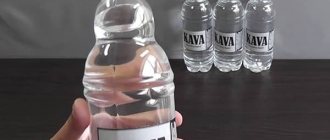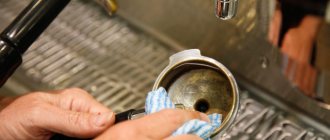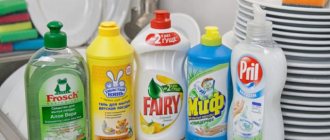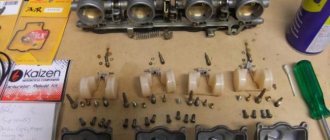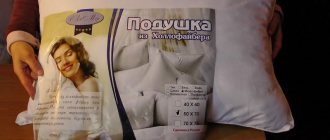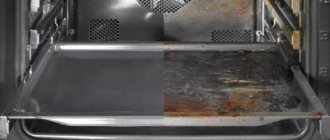How to clean your Jura coffee machine
To clean the coffee machine you need products adapted to it, developed by YURA:
- decalcification tablets dissolve scale;
- cleaning tablets remove plaque and scale;
- Milk system cleaning liquid (cappuccino maker liquid) removes deposited milk proteins and fats.
If cleaning is required, a corresponding message is displayed on the coffee machine screen. It may appear at different intervals as the machine reacts to changes in water hardness.
What is descaling machine
In the process of preparing coffee, ordinary drinking water is used, which contains calcium salts. There are slightly fewer of them in soft water. However, it is not possible to completely get rid of their presence during the filtration process. Calcium can be deposited on the walls of equipment, elements that are in direct contact with water - in the future, a layer of plaque may form in such areas.
Such deposits interfere with the efficient functioning of the coffee machine - it can work much worse, and the finished drink will acquire additional taste. To prevent this from happening, experts recommend periodically cleaning the coffee machine from the calcium layer. This process is called decalcification.
It is necessary to take into account the fact that water hardness directly affects the amount of plaque formed on the coffee machine. Experts recommend using this process monthly. To avoid the appearance of large amounts of sediment, it is recommended to use bottled water, which will also give a soft and pleasant taste to the drink.
Cleaning the cappuccino maker
It is important not to forget to remove dirt from the cappuccino maker during cleaning. This part of the coffee machine contains milk that spoils quickly. If you do not clean the cappuccino maker, the taste and quality of the drink will greatly deteriorate. The procedure is performed after each use of the milk tank:
- The milk container is removed.
- A water tank is installed in its place.
- Turn on the cappuccino preparation mode and circulate water through the foam formation system. The process is continued until clean water begins to come out of the cappuccino maker.
Quarterly cleaning of the coffee machine increases the service life and improves the quality of drinks. If necessary, the process is carried out earlier if the water in the water supply is too hard. Then it is useful to pour distilled water into the coffee machine. It contains a small amount of impurities and does not form significant sediment.
Source
Scale formation process
If you use filters of varying power before making coffee, some of the sediment will still remain in the water. When the cooking process occurs, the water gradually begins to heat up, and the salts themselves turn into a solid sediment that settles on the bottom and walls. However, particles on the coffee maker are formed not only by the influence of water, but also by the oil that is released from the coffee beans themselves during the brewing process. At Bravos coffee shops, we use medium roast coffee, which allows the machine to clog much more slowly due to its lower oil content.
This product also begins to thicken and settles on the sides of the coffee maker over time. The scale that forms from these elements can significantly impair the operation of the coffee machine and also adversely affects the taste of the finished drink. Cleaning your coffee machine with water is not the best way to get rid of this kind of residue. To destroy these substances from the walls of the unit, it is necessary to use specialized means. Our online store has a large selection of cleaning products; to find out more, fill out the form below and we will send you a wholesale price list.
How to clean your Jura coffee machine from coffee oils:
- the flush indicator should light up;
- fill the tank with warm water;
- press the rinse button;
- confirm washing by pressing the button again;
- empty the tray;
- place a glass under the tap;
- press the rinse button - the machine will begin to clean;
- wait for the message to appear on the screen indicating the need to add a tablet;
- throw the tablet into the ground coffee chamber, close the lid;
- press the cleaning button;
- the machine will drain water from the dispenser, from the cappuccino maker and from the brewing unit into the tray;
- empty the tray.
The entire cleaning process takes approximately twenty minutes.
How does scale affect the operation of a coffee machine?
The deposits that form on the walls of the device over time get into the machine components - thus, the cooking mode is disrupted. The coffee brewing temperature drops rapidly. When the coffee machine is turned on, you may notice an excessively loud noise, as well as interruptions in operation. The yield of the drink at the end of cooking also decreases. The most unpleasant thing is the deterioration of the taste of the finished coffee.
Cleaning the coffee machine should be carried out comprehensively:
- Remaining oil from coffee beans is removed;
- Scale is removed;
- The cooking temperature is restored;
- Coffee prepared using such a machine is of much better quality.
After comprehensive cleaning of the coffee machine, excess noise from the product disappears, and the service life of the equipment is restored.
An important and integral part of owning any coffee machine is care and cleaning. A coffee machine is, in principle, a device that requires attention. The fact that it can prepare coffee for you with one click does not mean that you can only press the buttons for your favorite recipes and not blow your socks off.
A special feature of JURA coffee machines is the built-in brewer. This means that it does not need to be taken out and washed under running water once a week, or lubricated once every 500 servings. In this regard, coffee machines with built-in memory require much less “current” attention. But because of this, I strongly recommend that you take your car to a service center for scheduled maintenance once every 1-2 years (depending on consumption). It just includes cleaning the insides and renewing the lubricant on the rubber seals of the brewing unit.
However, if you thought, “I’ll give it away once a year and won’t bother anymore,” then you’re wrong. Coffee machines require other types of cleaning, and JURA is no exception:
- Flushing the milk system, in two types: fast and deep.
- Cleaning from coffee oils.
- Decalcification (removal of scale).
Quick rinsing of the cappuccino maker
After each use, the cappuccino maker must be washed. It is clear that if you use it again after 5 minutes, there is no need to rinse it. Therefore, machines that work commercially and constantly froth milk are washed once at the end of the shift, and that’s it.
But at home, even a large family will have pauses in milk drinks for several hours. But even 30-40 minutes are already critical - the milk dries out quickly, and the dried protein is permanently deposited on surfaces. Taking into account the fact that for proper frothing it is important that all the holes in the cappuccino maker maintain their size (no more, no less), a couple of cleaning passes and the milk stops frothing. This is true for all coffee machines.
The JURA S8 has an automatic quick rinse for the cappuccino maker, which starts 15 minutes after the last use of the milk program. You don’t even need to confirm anything on the screen - convenient!
But there is a nuance. This quick rinse flushes the cappuccino maker unit, but does not flush the outlet hose. There are three solutions:
- Remove the hose each time and simply rinse it under the tap.
- Remove the hose once a day, for example in the evening, and soak it in “fairy”.
- Carry out an additional quick cleaning with water according to the example below.
I think the last option is more convenient. In essence, you are using a milk frothing program, only instead of milk there will be clean water. Below in the video I will show how you can make your own icon on the screen for this by setting the duration of the steam supply to 5-6 seconds - that’s enough - and naming the mode accordingly. By the way, after such a wash, the machine still “finishes off” with a standard auto-wash after 15 minutes just to be sure. The cappuccino maker is always in perfect condition.
Deep cleaning of the cappuccino maker
If you never skip the quick cleaning of the cappuccino maker described above, then the need for deep cleaning is reduced to almost zero. But, as practice shows, firstly, this is rarely possible. And secondly, the peculiarity of the JURA S8 is that it still asks for this deep cleaning, displaying a warning at the top of the screen. Moreover, she remembers that such cleaning was not done even after turning off and then turning on the device. And it immediately displays a request for deep cleaning of the milk system.
Here, on the one hand, you can simply ignore this message. On the other hand, carry out deep cleaning. The manufacturer advises doing it every day with a branded product, 30 grams of which comes with the coffee machine in a convenient dispenser. But it implies that you do not carry out quick cleaning according to the scheme above, and the milk hose, the hose itself, is “in milk” all day.
Indeed, you don’t have to think about quick cleaning at all and only do a deep cleaning once a day. But this requires chemistry for dairy systems.
Therefore, here the choice is yours; you can do a quick cleaning according to the scheme above, and ignore the request for deep cleaning, or simply carry out deep cleaning with clean water. Or vice versa, do not do a quick rinse and do a deep rinse with product once a day.
Be that as it may, for deep cleaning of the dairy system, the manufacturer included not only a little branded product, but also a special bath to which the cappuccino maker tube is connected. The bath is not simple, it has two compartments - one for chemicals (diluted with water to the mark), the second for draining the water. The on-screen instructions are clear and the process is quick and simple. But it’s better to show it on video than to describe it in words:
Cleaning the cappuccino maker with disassembly
There is a third approach: do not clean either “quickly” or “deeply,” but once a day or two, disassemble the cappuccino maker module and soak it in fairy. Disassembly is not difficult, you need to soak it for an hour or two, then rinse all parts under the tap and let them dry, and then assemble them. Again, show the video more clearly:
The same method should help in cases where the cappuccino maker is already so clogged that even deep cleaning with proprietary chemicals does not help. If disassembling and soaking does not help, the milk still does not foam properly, or the cappuccino maker continues to spit, then there is some kind of malfunction.
Cleaning coffee oils
This type of cleaning is especially important for coffee machines with a built-in brewer, such as the JURA S8. I strongly do not recommend ignoring it. The process cleanses the entire hydraulic system, including the brewing unit, of coffee oil deposits. It is carried out using tablets with chemicals; a package of 2 pieces is supplied with the machine. The machine itself issues a request for such cleaning, the frequency depends on the amount of water passed through the machine, but the guideline is 180 servings.
In the maintenance menu, under each button that starts any cleaning process, there is a thin red bar that grows over time. This is an indicator that a cleaning request of this type is approaching. But in principle, no one forbids cleaning more often if you suddenly have such a desire.
During the de-oiling process, you will need to empty the drip tray and grounds container twice, at the beginning and at the end, and place one tablet into the ground coffee chamber. Plus, you need two empty containers to drain the waste - it drains from both dispensers. The whole process, judging by the machine's prompt before starting, should take about 20 minutes. In the example below, I completed it in 11:30.
Descaling – descaling
This cleaning is carried out at the request of the coffee machine and requires either proprietary chemicals (not included in the delivery kit) or some analogue, I wrote about this in the profile material. The frequency of descaling directly depends on two factors:
- Do you use branded Claris SMART water filters (one included). If yes, then decalcification is not necessary.
- What water hardness is set in the global settings of the coffee machine (I wrote about this in the second diary entry, when I put the machine into operation for the first time).
It’s clear with filters - change filters, no hassle. But convenience comes at a price. Many choose the second option and use external water treatment. If you only fill the coffee machine tank with water from a reverse osmosis system, you can decalcify once a year to clear your conscience - scale will still not form after osmosis.
Otherwise, you need to adequately set the water hardness and not miss requests for decalcification. The whole process is generally similar to cleaning coffee oils, but the chemical must be dissolved directly in the water tank (in 500 ml of clean tap water), and it takes significantly longer, about 30-40 minutes. I won’t show the video, because there’s nothing interesting there, but I repeat, all the tips on the screen are obvious, there’s nothing complicated.
After carrying out any type of cleaning, except for quick rinsing of the cappuccino maker, the corresponding counter in the coffee machine settings menu increases by 1. The “Cleaning” item refers to cleaning from coffee oils:
This boring part of "life" with a coffee machine is actually important, don't neglect all this cleaning and the equipment will serve you faithfully for many years.
Where to buy Jura S8 EA in Moscow and regions:
Publication date: 07/12/2021.
Your opinion is important to me. Please rate the material: (Total ratings: 2. Average: 5.00 )
What specialized products are recommended to use to combat scale?
Most branded companies offer their own products for cleaning equipment from scale and oils. Among the strongest are Philips, Dolce Gusto, Delonghi and Saeko. The composition of these products is relatively the same, so the tablets and products are suitable for cleaning almost any model of coffee machine.
It is not necessary to purchase expensive cleaning products to cope with this problem - you can purchase cheaper analogues that are made by less well-known brands. Such substances can be produced in various forms: they can be liquids for washing coffee machines, tablets or powders. In some cases, you can also find folk remedies to combat scale - some users prefer to wash the car with citric acid.
Coffee oil removers for coffee machines
It is necessary to distinguish the removal of coffee oils from decalcification - descaling; These are different manipulations and different means are used for each procedure. Coffee oils in a coffee machine are removed using special products available in the form of tablets or liquid. All of them are designated as “Clean”, “Cleaning”, etc. Each contains phosphates, persalt, and acids intended for the breakdown of fats. The form of the product is not of fundamental importance; the composition of liquids does not differ from the tablet form. But the liquid dissolves instantly in water, and the tablets are more convenient to store, so it’s up to you to decide which is preferable.
You can purchase funds in stores that sell coffee machines or household appliances, as well as in service centers for the repair and maintenance of coffee equipment. Cleaning products from well-known manufacturers Bosch, Melitta, Jura are considered the best, although, as practice shows, the cheaper ones Topper, Cafiza, etc. are no worse. Today there are products on sale for simultaneously removing both coffee oils and scale, but such combinations are worse than separate preparations .
One tablet or portion of liquid is designed for one procedure; there is no need to divide it to save money, or use two for greater effect. If more intensive cleansing is required, two cleanses should be performed.
How often is it recommended to clean your car?
A lot depends on the quality of the water used to prepare the drink. If hard water is used as a base, then it is necessary to clean the device every 1.5 months. If the water is soft enough, then a period of about 6 months is sufficient. In order not to miss cleaning time, it is recommended to pay attention to the condition of the machine itself, as well as its functioning. If performance indicators begin to change for the worse, then it is necessary to clean its device from scale and oil.
Decalcification is not the only process that needs to be carried out periodically in the machine. You also need to regularly clean the cappuccino maker, if you have one (this is an element that allows you to efficiently froth milk). In order to ensure good care for it, it is enough to periodically rinse the cappuccino maker with water (it is best to use bottled water).
It is recommended to do this cleaning after each use of the device. The fact is that leftover milk is an excellent environment for the spread of bacteria and microorganisms. Also, scale may also accumulate on the cappuccino maker, causing the element to stop working. Then you will have to use special cleaning products.
How to clean a coffee machine: sequence of steps
Different types of devices have their own cleaning characteristics.
- Expensive devices have a separate program for cleaning, and everything happens automatically - you just need to pour a special product into the water tank and press the button.
- Coffee machines are easier to clean manually - through successive clicks and actions. There is no universal recipe. Each model has its own characteristics.
The sequence of actions when cleaning the coffee machine is described in the instructions for the device. Open the book and follow from point to point.
Sometimes you need to perform about 10 operations in 20 minutes. You need to be very careful, otherwise you will have to start cleaning again. The instructions describe the entire process briefly and clearly. There should be no problems with its interpretation. If the booklet is lost, the instructions can be downloaded from the Internet. You must enter into the search the name of the coffee machine and the exact model indicated on the case.
To descale your DeLonghi magnifica coffee machine:
Decalcification of the Saeco Royal coffee machine:
How to Know When to Clean
Before you start using a specific cleaning product, you need to determine exactly whether the device currently needs to be cleaned. On more expensive models, you can find an indication system that allows you to determine how dirty the machine is at the moment - it gives certain signals that indicate that the coffee machine needs to be cleaned. However, the sensors cannot determine the quality and type of water, nor the amount of accumulated sediment. The operating principle of such indicator systems is quite simple.
The system already knows in advance how many cups of coffee the coffee machine is designed for before cleaning (on average, this figure varies around 230 cups). Once the cooking limit is reached, the equipment begins to signal that it needs to be cleaned - although in fact this may not be necessary. The machine is more suitable for preventative cleaning.
Some coffee makers allow the owner to independently enter data on water hardness. To help the user navigate this indicator, the manufacturer also includes a water hardness test. A system of indicators built on such an algorithm is distinguished by more accurate indicators.
If the model does not have any indicators, then the owner has to rely on the eye. To do this, you need to know the signs by which you can determine that the machine needs cleaning:
- During operation, uncharacteristic sounds appear, as well as too much noise;
- A thin stream of coffee;
- Coffee becomes less strong;
- The drink has an unusual taste;
- The amount of finished coffee becomes much smaller;
- Sediment appears at the bottom of the drink.
If the owner of the device notices these signs when the equipment is operating, this directly indicates the need to clean the machine. Otherwise, the device may break down completely.
However, before you begin the procedure itself, you must carefully read the instructions from the unit. Usually the manufacturer gives recommendations for decalcification of a specific model - all the nuances that you need to know about will be spelled out here.
Cleaning time
Models created for cafes need to be cleaned every day, home coffee machines - once a week.
The water filter must be changed every two months, the water tank must be rinsed and filled with fresh water daily. The tray must be washed when it gets dirty. It is better to clean the waste cake container every day, otherwise it will ruin the aroma of the coffee.
The milk hose needs to be changed every three months. If you constantly use milk, it is better to clean it daily.
It is not recommended to wait longer than this period, as there is a risk of damage to individual elements of the coffee machine.
What you need to prepare to clean the coffee machine
Before you start cleaning the coffee machine, you also need to decide on the method and select the appropriate product that will help deal with scale and remove complex deposits. Here you can choose several solutions at once:
- Buy an expensive branded product;
- Buy its cheaper analogue;
- Use traditional methods (this is the riskiest option).
When choosing, you need to take into account that branded products usually cost much more than regular ones. Most often, manufacturers recommend using them for a specific brand of device - the manufacturer speaks of the high efficiency of such equipment. In this case, the form of release can be completely different: liquid substances. Powders and tablets. They must be used according to the accompanying instructions.
How to clean a device with an auto-cleaning option?
If your machine is not equipped with a display, but has an automatic cleaning function, then a flashing indicator or a corresponding illuminated icon will indicate the need for decalcification.
Here you need to do this:
- Turn on the device, wait until it warms up and flushes the system.
- Click on Descale or Cale - hold the key for about 5 seconds.
- The machine independently cleans the beverage dispenser, after which it “asks” to add an anti-lime preparation.
- You can descale your coffee machine using either special gel or tablets for coffee machines.
- If you have a liquid cleaner, pour 150-500 ml of the product (based on the dosage in the instructions). If necessary, increase the volume to 0.5 l - this is the mark on the Cale tank.
- To clean a coffee machine at home using tablets, you will need 2-3 pieces - they are placed in the water tank of the machine, filled with 0.5 liters of water, and wait until completely dissolved.
- Place a basin or bowl under the coffee machine tap that can hold 0.5 liters of water.
- Cleaning the coffee machine with a tablet is very simple. Depending on the model, click on “Start”, “OK”, “Steam”.
- The machine will run 100-150 ml of water at a time, taking breaks of 5-10 minutes, until the entire supply of cleaning product in the tank is exhausted. In this case, the pump may operate unusually loudly, even crackling.
- When cleaning is complete, the “Add water” or “Empty tray” indicator will appear. Rinse the water tank of the machine thoroughly and add water to the maximum level.
- Run one or more water tanks.
- Once the cleaning is complete, the machine will alert you that the cleaning cycle is complete.
If you have a modern model with both the auto-wash option and a display, then the process is much simpler:
- To clean the same Bosch coffee machine, turn on the machine, wait until it warms up and rinses itself from the inside.
- From the menu, select Maintenance, Care or Cleaning. Next, stop at Descale, Cale or “Descaling”.
- The machine will do 1-2 cleaning cycles through the feed dispenser, after which it will ask you to add a cleaning product.
- Dosage - as in the previous guide: 150-500 ml of liquid product or 2-3 cleaning tablets for coffee machines. In any case, add water to the 0.5 liter mark on the tank and wait until the product is completely dissolved in the water.
- Place a large container under the faucet of the device, open the steam tap or click on “Start”, “Ok”.
- The equipment will begin to circulate 100-200 ml of cleaning solution through itself, taking breaks of 5-10 minutes - until it is all gone.
- When the machine asks you to add water or empty the tray, remove the water tank, rinse it thoroughly, then fill it with clean water to the maximum value and return it back.
- For complete cleaning, it is necessary to add from one to several tanks of water in this way.
- As soon as the washing is completely completed, the machine will inform you about this with a message on the screen.
Instructions for descaling your coffee machine
Despite the fact that each cleaning product comes with specific instructions, there is a certain procedure that will be universal in any situation:
- All components of the device are preliminarily cleaned of any remaining coffee beans, and excess waste is also removed. It is necessary to pour out the remaining water.
- The product is dissolved in water according to the instructions in a specific proportion;
- The substance must be poured into a compartment with water;
- Then the coffee machine starts working - after 5 minutes it is necessary to completely drain the liquid from the compartment;
- The reservoir must be rinsed under running water and filled with clean liquid;
- You need to start the coffee machine again;
- After this, it is necessary to carry out another complete water change - after which the coffee machine can be considered completely cleaned.
Expensive models that have a sprayer or horn in their design can be cleaned without adding coffee to the tank. There are even options that provide automatic tank cleaning. Here then it is enough just to follow the instructions from the manufacturer.
Procedure for cleaning the milk system:
- find the “Cappuccino cleaning” tab in the service menu - the coffee machine will ask for a milk system cleaner;
- Dissolve 15 ml of the product in 1 liter of warm water;
- lower the milk tube into the solution;
- press the “confirm rinsing” button (right under the screen);
- the milk system will begin to flush;
- Fill a container with clean warm water and lower the milk tube into it;
- Press the “confirm rinsing” button again - the machine will be rinsed with clean water.
Using folk remedies for cleansing
If you don’t want to spend money on expensive products to clean your coffee machine, you can resort to traditional methods of getting rid of scale and sediment. Owners of coffee makers are recommended to use solutions of vinegar or citric acid. Specialists who repair such units insist that for cleaning it is still better to use professional products that will certainly not cause harm to the device.
Vinegar and citric acid are very caustic substances that can damage the surface of the coffee machine, causing it to work much slower or simply break completely. However, if you do everything correctly, this risk will be minimized. Each method is discussed in more detail below.
How to determine that the device needs cleaning: signs of a dirty coffee machine
It happens that the coffee machine works as usual - it does not make noise, brews quickly, milk is supplied without interruptions - but the coffee turns out sour, with a bitter aftertaste. This means it's time to clean the device. And the bad taste of the drink is not the only sign of a clogged machine.
If the coffee machine does not have an indicator indicating the need for cleaning, determine this yourself . Characteristic features:
- the taste of coffee has changed - sour with rancidity;
- a sediment in the form of scale forms at the bottom of the mug after the coffee is drunk;
- water takes longer to heat up than usual;
- the drink is poured into the mug difficultly, slowly, in a thin stream;
- The coffee machine is louder than usual and makes a crackling noise.
Interesting things on the site:
Coffee capsules for coffee machines - which ones are better?
What are pods for coffee machines and how to use them
Rating of electric coffee grinders for home
Vinegar Cleaning Method
The first step is to prepare a vinegar-based cleaner. To do this, take a 9% solution of table vinegar and water in a ratio of 1 to 2. Next, you must follow the same procedure as when using a branded cleaning product. The entire algorithm of actions was described in detail in the previous paragraphs. If we turn to the opinion of experts, most of them insist that the vinegar solution can damage the internal components of the device. Therefore, it is recommended to use it only in the most extreme situations.
How to use
Before carrying out the procedure, read the Topperr instructions for descaling coffee machines.
The concentrated liquid preparation from this company is used as follows:
- Add 100 ml of the drug to 2 liters of warm water.
- Stir and pour the liquid into a water container.
- Start the decalcification process (the method depends on the coffee machine and is indicated in the operating instructions for the specific model).
- After cleaning, remove the removable parts, rinse with running water without detergents and dry before installation.
Decalcification tablets are used differently:
- Remove the protective film from the tablet.
- Place the tablet in a water container and fill it to the brim with boiling water.
- Wait for the product to dissolve.
- Run the coffee maker 1 full cleaning cycle.
- Then run the full cycle 3 more times with clean water to rinse the internal parts.
In coffee makers with a built-in cleaning function, essential oil tablets should be used as indicated in the instructions for the specific model. If there is no such parameter, perform the procedure as follows:
- Pour water into the container provided for this purpose in the coffee maker.
- Place the tablet in the coffee compartment.
- Place the mug under the dispenser, turn on the drink preparation mode and fill it halfway.
- Turn off the coffee machine and leave for 15-20 minutes. The remedy should work.
- Drain the brewed “drink”, turn on the unit and let it complete the interrupted cycle.
- Disconnect the brew unit, rinse it under water and put it back.
- Run the full coffee brewing cycle 2 more times, but do not add ground beans.
The drip tray into which drips drain also needs regular cleaning. Place a Topperr descaling tablet in it and pour boiling water to 2/3 of the volume. After half an hour, rinse the container under the tap.
Cleaning technology using citric acid
Most equipment repair specialists find this method more acceptable and safer. To make a cleaning product, you need to dilute 30 g of acid per 1 liter of water. After this, it is recommended to use the same algorithm of actions as described above - the principle of operation is the same as that of specialized cleaning products. Experts in this field say that citric acid will indeed effectively remove accumulated scale, but if you overdo it, the solution can negatively affect the operation of the parts of the entire coffee machine. It is better to use such a product rarely, so as not to damage the device ahead of time.
Why do coffee machines get dirty?
Any model of coffee maker becomes dirty due to hard tap water with mineral salts, which leaves a residue during the preparation of the drink. It accumulates on the water heater and other internal parts. Automatic flushing will not help avoid this problem.
The softer the water, the slower plaque forms. But over time, it becomes thicker, worsens the taste of the drink and disables the equipment. Therefore, coffee machine maintenance includes regular decalcification. After cleaning, the coffee will not have a limescale taste, and the equipment will last longer.
Also, the equipment gets dirty with coffee oils, which are formed when grinding beans and brewing the drink. Such plaque cannot be washed off with plain water.
Signs of a clogged coffee maker
When using water containing hardness salts, scale will inevitably form in the coffee maker. Both simple drip and capsule or carob coffee makers are susceptible to clogging.
The more bends and smaller the diameter of the tubes for the passage of water in the coffee maker, the greater the likelihood of scale formation. Lime scale particles clog water flow channels.
Not all coffee makers are equipped with a built-in indicator (a counter for the number of cups of coffee brewed), so you need to be able to recognize signs of limescale deposits inside the machine:
- It takes longer to prepare one serving of drink than before;
- if the tube and outlet are clogged, the stream of ready-made coffee becomes thin, causing the cup to take longer to fill;
- the taste of the drink has deteriorated;
- there is a foreign smell;
- the operating device began to make unusual sounds;
- a light gray sediment is visible in the cup;
- Electricity consumption has increased while the coffee maker is operating.
According to repair specialists, boiler-type capsule and carob coffee makers are most susceptible to heater overgrowth and tube clogging. In devices with a thermoblock, water does not stagnate, and the process of scale formation proceeds more slowly.
If limescale deposits have appeared, you need to get rid of it, and descaling the coffee maker is also possible at home.
In very advanced cases, the coffee maker will have to be disassembled
How to properly rinse the cappuccino maker of a capsule coffee machine
If the capsule coffee machine is intended not only for making espresso and Americano, but also prepares drinks with milk, then in addition to general cleaning, do not forget about the cappuccino maker. It can be stand-alone or built-in.
In any case, it is worth washing it after each use. The autonomous cappuccino maker is washed like regular dirty dishes - in soapy water using a soft cloth or sponge. To thoroughly rinse the built-in cappuccino maker, you need to lower its tube into the washing solution and run it several times. Then repeat the same steps 2-3 times with plain water to wash off any remaining detergent.
Home remedies for cleaning a coffee machine
Some experts say that you can use improvised products, such as cola and vinegar, to clean coffee machines. Experts say that this method will have a bad effect on the device. It is necessary to use special cleaning products; citric acid is also suitable as a homemade solution.
De-scaling a coffee machine with citric acid is a fairly effective method, as well as a safe one. The substance has absolutely no harmful effects on the human body, unlike household chemicals that are used in everyday life.
The process of descaling a coffee machine using citric acid:
- Disconnect the device from power.
- Pour 1 liter of water and 4 tsp into the bowl. citric acid.
- Wait for the powder to dissolve.
- Turn on the coffee machine and press the automatic cleaning mode.
- The solution must be completely consumed, otherwise it may enter the human body.
The second stage is rinsing. The coffee maker should be thoroughly rinsed to remove any remaining product.
The third stage is a secondary rinse with water. Fill the reservoir with distilled liquid and turn on the coffee brewing mode. Try to pour out all the water by running it through the machine.
For you:
Choosing a coffee maker for home use
Citric acid is suitable for any appliance. It does not spoil the internal elements of the device and is cheap in its price range. Previously, households did not have the cleaning products that now overflow store shelves. People had the opportunity to use citric acid. Soon the advertising drove us into a dead end and now few people remember how effective the cleaning method using citric acid is.
How to clean a cappuccino maker
The milk frother requires regular cleaning to remove milk fat. If you do not carry out the procedure, the device will emit a rather unpleasant odor. Milk fat often settles on the walls of the tubes. If the milk compartment is removable, it will be much easier to clean, since you can visually assess the presence of a fatty layer.
If you have a built-in model, then you need to use professional tools and carry out the procedure with the frequency recommended by the manufacturer.
The coffee machine does not form a tablet - the main reasons for the malfunction
When the coffee waste container is working properly, clearly formed tablets come out. If there is any deviation from the norm, then something is wrong with the coffee machine and you need to look for the problem. It is likely that the reason may be due to operation. Then it is not necessary to involve specialists. You can configure the system yourself.
Many parameters can affect the longevity of the tablet: the type and grinding of beans, the amount of water, the strength level.
One of the reasons why the tablet may be liquid is the wrong mode for the selected coffee drink. Perhaps you are preparing a large volume of espresso in one shot. This is very bad, because after spilling a certain amount of water, bad fractions begin to flow. If you want to prepare a large volume of any drink, it is better to make a double espresso or Americano.
Another reason is the wrong choice of grinding degree. The tablet may not form well if the grind is too coarse. This type of coffee can be prepared in a Turk so as not to clog the horn. Modern coffee machines provide this feature. Manufacturers include 8 adjustable grind levels. If it's hard for you to decide, choose medium.
